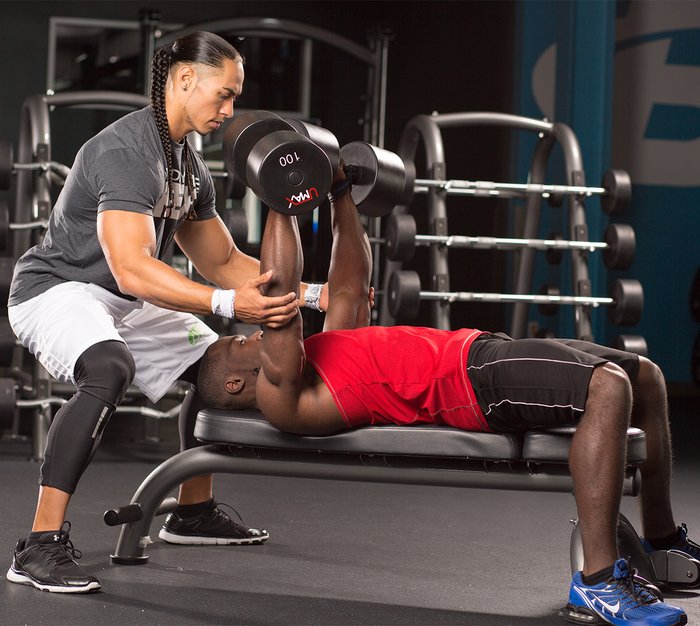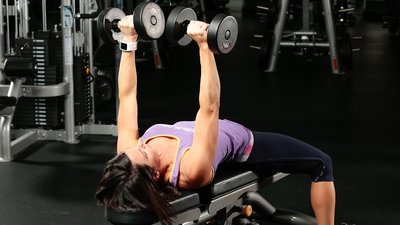While the barbell bench press is often considered the top mass builder on chest day, its cousin, the dumbbell bench press, isn't far behind. In fact, many lifters swear that dumbbells yield better muscle-building results than the bar.
Of course, execution has a lot to say about the effectiveness of either type of weight. But it's clear that even though you sacrifice a little in terms of load when going from the barbell to dumbbells, the latter offers some benefits the former can't offer.
Let's dig into them, and analyze how you might place this move in your chest workout.
What's So Great About the Dumbbell Bench Press?
Each side works independently during dumbbell presses, which allows you to identify and correct strength deficiencies between sides. The dumbbell version is also more difficult; it can have a longer range of motion, and it requires greater muscle-stabilizer activation to keep the weights stable. If you've got sore shoulders that are aggravated when doing barbell presses, you may even find that dumbbells allow more freedom around your shoulder joints—and less pain.
In short, the flat-bench dumbbell press is likely a solid addition to just about every bodybuilders' chest routine. How you approach it on chest day, however, depends on what position you put it in your workout order. Let's consider how you should do flat-bench dumbbell presses if you perform them at the beginning of your routine, and how that differs from doing them in the middle or at the end.
Beginning of Workout: Keep it at 6, and bring the intensity
The dumbbell bench is an excellent substitute for the barbell bench press, though it can quickly get dicey if you want to do very low reps with very heavy weights, or single-rep max training. It's more difficult to spot, and positioning the weights in the start position is harder. Losing control can also increase your risk of shoulder-joint damage.

As a first movement, don't be afraid to use heavier bells and give your body a strength stimulus. However, I don't recommend taking your sets any lower than 6 reps. With the aid of a training partner, you can make even lighter weights feel much heavier by using intensity techniques like forced reps or negatives to push past failure.
If you do this movement as your big-buck push, I would also recommend incorporating some variety into your chest routine by using different bench angles, rather than just following it up with, say, the flat barbell bench.
Middle of Workout: Knock out Your Reps and Move on
If you do this movement toward the middle of your workout, you should have already hit the other major bench angles such as incline and decline, which can be done first if you're targeting your upper or lower pec region, respectively.
In addition, your strength will be somewhat compromised by the work you've already done, so now is definitely not the time to be training for strength with low-rep sets. Instead, use loads that allow you to perform 8-10 reps, the middle of hypertrophy range.
Take these sets to muscle failure, but be highly selective with the amount of post-failure training you do here. Many lifters favor such techniques at the beginning of their chest workout, when they have the most strength, or toward the end, when they're using cables, machines, and other implements that are less risky and precarious than dumbbells.
End of Workout: Choose High Reps and Dropsets
It's pretty uncommon to see the flat-bench dumbbell press at the tail end of a chest workout, since it requires so much stabilization and balance. This part of your workout is usually focused on the muscle burn and pump, one reason why lifters often gravitate toward non-free-weight options here.

That doesn't mean it's wrong to pick up the bells here, though. Doing so often means slightly lighter weights, like sets of 12 reps or more, or doing dropsets at the end. This is less a strength technique than one in which you signal hypertrophy by a mechanism known as metabolic stress, which is commonly done with rep-out and pumping techniques.
The flat-bench dumbbell press might also be done last if you're following a pre-exhaust type of routine in which you flip-flop your single-joint and multijoint exercises. If you want to highly reduce stabilizer activity on your final exercise, I recommend opting for the machine version instead, so you don't have to balance the weights.

